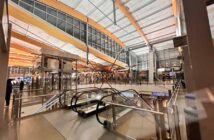
Hamburg Helmut Schmidt Airport, located 8.5 kilometres north of Hamburg’s city centre in Fuhlsbüttel, serves as Germany’s fifth-busiest airport and a hub for Eurowings, with focus city status for Condor. Handling over 13.5 million passengers annually, it connects to 130 destinations across 40 countries, including major European cities like Dublin, London and Amsterdam, and long-haul routes to Dubai and Doha. Its modern infrastructure and efficient operations make it a welcoming gateway for travellers exploring northern Germany or connecting globally.
The passenger experience at Hamburg Airport is designed for convenience. The airport features two interconnected terminals—Terminal 1 for major carriers like Lufthansa and Emirates, and Terminal 2 for low-cost airlines like Ryanair and easyJet—linked by the Airport Plaza, a central hub for security, shops, and services. Arrivals typically involve a short walk via one of 17 jet bridges or a quick bus transfer from the tarmac. Check-in, with 80 counters and self-service kiosks, is generally smooth, though kiosks can take 10–15 seconds to load, and some travellers report long queues during peak times.
Security screening, equipped with advanced scanners, requires liquids in a 1-litre bag and electronics removed, with wait times averaging 10–20 minutes but occasionally reaching 45 minutes due to staffing shortages or strict checks. The free Slot & Fly service, bookable online within 72 hours of departure, allows passengers to reserve a 15-minute security timeslot, reducing wait times. Staff are courteous, and a free assistance service for passengers with reduced mobility, bookable 48 hours in advance, ensures accessibility with ramps and lifts throughout. Some passengers note outdated restrooms and limited seating during busy periods, but clear signage and digital flight displays aid navigation.
Accessing the airport is straightforward, with excellent public transport links. The S-Bahn S1 line connects Hamburg Hauptbahnhof to the airport in 25 minutes for €3.50, with trains every 10 minutes from 4:30 am. to midnight. The U-Bahn U1 line, accessible via a change at Ohlsdorf, offers additional connectivity. Buses, including the Kielius shuttle from outside Hamburg, cost €10–€15, while local routes like 23 and 27 serve nearby areas.
Taxis, available at both terminals, cost €25–€30 to the city centre, with fixed fares for pre-booked trips. Car hire desks from Avis, Europcar, and Hertz are in the arrivals area, and over 12,000 parking spaces across P1–P5 lots, starting at €4 per hour, are within a 150-metre walk of the terminals, with online reservations recommended. Traffic on the A7 or roadworks on Zeppelinstrasse can slow journeys, so checking www.hamburg-airport.de for updates is advised.
The airport’s layout is logical, with Terminal 1 (14 gates) handling non-Schengen flights and Terminal 2 (8 gates) focusing on Schengen routes. The Airport Plaza houses the main security checkpoint and baggage claim areas, with 54 aircraft parking positions and a 3,800-metre runway supporting widebody aircraft like the Airbus A380. The walk between terminals takes 5–7 minutes via the Skywalk, and shuttle services assist with luggage. Recent upgrades, including a 500-metre pier extension and modernised waiting areas, enhance flow, though seating can be limited during peak summer and holiday periods.
Delays are generally minimal, with strong on-time performance, though average delays of 15–30 minutes can occur during peak seasons due to weather, staffing shortages, or air traffic control issues. Travellers should arrive two hours early for Schengen flights and three for non-Schengen to account for potential security or check-in queues. Dining and retail options are plentiful. The Airport Plaza and airside areas feature fast-food outlets like McDonald’s, sit-down restaurants like Marché Mِvenpick, and cafes like Simit Sarayı, open from 5 am. to 10 pm with 24-hour vending machines. Heinemann Duty Free, Relay, and fashion stores offer souvenirs and essentials, though some note higher prices. The Airport Lounge (€45, 3 hours) and Lufthansa Lounge (€25) provide snacks, drinks, and Wi-Fi.
Facilities cater to diverse needs. Free Wi-Fi is available with registration, though connectivity can be spotty. ATMs, a pharmacy, medical services, and a children’s play area are present, alongside showers, luggage storage (€3–€5/hour), and wrapping stations. EasyPASS e-gates expedite border control for eligible passengers, and a visitor terrace offers apron views. Accessibility features include low-floor buses, ramps, and wheelchair services. Connections benefit from a 35-minute minimum connection time for all flight types, with the single-terminal setup and Skywalk simplifying transfers. Self-transfers require clearing security and immigration, so a 90-minute buffer is recommended. Weather, staffing, or equipment issues like malfunctioning conveyor belts can disrupt tight schedules.
Aer Lingus
Aer Lingus operates from Terminal 2 at Hamburg Airport for flights to Dublin. Check-in desks are typically in the Check-in Area A or B (desks 1–20 range), but exact assignments vary. Check-in opens 2 hours before departure and closes 45 minutes before departure. Online check-in is available 30 hours to 4.5 hours prior. A
Departures are most commonly from gates in Terminal 2 (e.g., 20-41, non-Schengen); dynamic, announced ~40 minutes before departure. Specific gates are displayed on airport screens or via the Aer Lingus app. Arrive 90 minutes before departure to clear security at this busy airport.
Ryanair
Ryanair Ryanair operates flights to Dublin on Mondays, Wednesdays, Fridays, Saturdays, and Sundays from Terminal 2, with check-in desks typically in the check-in area (desks 20–40). Bag drop opens 2 hours prior. Departures are most commonly from gates 20-41 (non-Schengen; dynamic, shown on screens ~30-45 minutes before departure). Specific gates are confirmed on departure boards.



